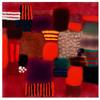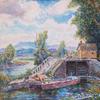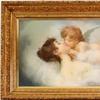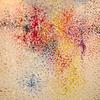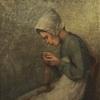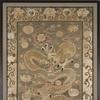Huntington Acquires Works by Several African American Artists, John Marin Oils, and a Tiffany Chair
- SAN MARINO, California
- /
- June 18, 2019
The Art Collectors' Council of The Huntington Library, Art Collections, and Botanical Gardens funded the purchase of several notable American works at its annual meeting last month, signaling a commitment to grow and diversify The Huntington's holdings of works by modern and contemporary artists while continuing to build its collection of historical art. The Huntington acquired a group of 32 colorful etchings made between 2005 and 2014 by four artists—Louisiana Bendolph, Mary Lee Bendolph, Loretta Bennett, and Loretta Pettway—who are part of the Gee's Bend group of quilters. Also acquired was a collage, Blue Monday (1969), made by celebrated African American artist Romare Bearden at the height of his career. Two paintings (1910-1916) from the seminal Weehawken Sequence by John Marin of Alfred Stieglitz's circle, as well as a rare Tiffany chair (1891-93) rounded out the acquisitions.
“Any one of these artworks would have been a meaningful addition to the American art collection,” said Christina Nielsen, Hannah and Russel Kully Director of the Art Collections, “but the addition of the group of prints by the extraordinary Gee’s Bend group, along with the magnificent Bearden collage, allow us to incorporate more voices into the story of American art, and are therefore especially significant. This year, the Collectors’ Council really stepped forward to further fill a gap and expand the narrative.”
The new acquisitions will go on view in the Virginia Steele Scott Galleries of American Art over the coming months.
Louisiana Bendolph, Mary Lee Bendolph, Loretta Bennett, and Loretta Pettway, 32 color soft-ground etchings with aquatint, 2005–14. Variable dimensions. Published by Paulson Fontaine Press, Berkeley, CA
In 2002, about 40 little-known quilt makers, all African American, from the hamlet of Gee’s Bend, Alabama, took center stage in the art world thanks to an exhibition at the Whitney Museum of American Art. Their original art making, with no intentional connection to modernist abstraction—though often compared to it—received rave reviews from art critics and charmed the nation as news and films that highlighted their unique work spread. In 2005, Paulson Fontaine Press, a fine art print studio in Berkeley, California, invited Mary Lee Bendolph, her daughter in-law Louisiana Bendolph, Loretta Bennett, Loretta Pettway, and two additional artists from Gee’s Bend, Alabama to collaborate on a print series. After conversation with the printers at the press, the artists landed on a soft-ground etching technique in which small quilts were pressed onto a wax-coated plate. This captured the seams, fabric weave, and the wear typical of Gee’s Bend quilts.
The 32 works by Bennett, Pettway, and the Bendolphs that were acquired by The Huntington will enrich the collection, said James Glisson, interim chief curator of American art. “These are fantastic prints, boldly colored, and striking in design. In the prints, the artists’ captured the effects of denim and cloth worn from washing and years of use, but juxtapose those with dazzling colors. This push and pull between new and old, bright and faded makes them evoke age and wear but in a happy, buoyant way.” The Gee’s Bend etchings build on The Huntington’s strong collection of 20th century prints as well as add the works of four contemporary artists to the collection.
Romare Bearden, Blue Monday, 1969. Papers on fiberboard, mounted to board, 12 × 9 in.
The young Romare Bearden thrived in the vibrant New York milieu of African-American intellectuals and artists of the 1950s, which included his cousin Duke Ellington, and the novelist Ralph Ellison (who wrote about Bearden). Though initially a painter, Bearden’s star began to rise in the early 1960s when he took up collage. Bearden said of collage that it is “as if I were improvising like a jazz musician.”
“Bearden would pick a theme, manipulate it, and try some variations,” said Glisson. “In Blue Monday, the bright blue, dark blue, and orange establish a syncopated rhythm that floats above the grey papers and greyscale magazine photographs like a saxophone’s sharp notes over the deeper tones of an upright bass.”
Blue Monday might allude to George Gershwin’s 1922 “Blue Monday” jazz opera set in Harlem, or to Fats Domino’s 1956 hit of the same name, which bemoans the dread of starting the work week. “Despite the liveliness of the color blocks, this collage does feel slow and meditative, like an interminable Monday at the office after an overactive weekend,” said Glisson.
Bearden is one of the most significant African American artists of the mid-20th century. Blue Monday is a strong example of work from his most sought-after period, and has appeared in retrospectives at the Museum of Modern Art (1971) and Harlem’s Studio Museum (1991). Its acquisition not only supports The Huntington’s commitment to diversifying its art collections but also fits well with an existing strength: Collage is already a focal point of the collection with Robert Rauschenberg’s Global Loft (Spread) (1979), Betye Saar’s The Fragility of Illusion (1981), Robert Motherwell’s, Untitled screen print and paper collage (1964), and examples by Joseph Cornell (ca. 1969), among others.
John Marin, two paintings from the Weehawken Sequence, 1916. Oil on canvas board.
The two lively and evocative oil sketches by modernist John Marin (1870-1953) that were acquired are from a group of roughly 100 that the artist created between 1910 and 1916 in the New Jersey township of Weehawken. Both landscapes feature an angular leafless tree at the center surrounded by slashes and daubs of paint in a distinctive and lush color palette and were important early experiments in abstraction and expression. Marin was one of the first American painters—along with Arthur Dove and Marsden Hartley, both represented in The Huntington’s collections—to employ elements of abstraction in his work. Like so many American artists of his time, Marin traveled to Paris in 1905, where he met artist Edward Steichen and Alfred Stieglitz. Stieglitz not only mounted Marin’s first solo show in 1909 at his famous gallery “291” in midtown Manhattan, but also financially supported the artist over the remainder of Marin’s career. In 1910, Marin returned to his native New Jersey, his creative impulses fueled by his time in Europe. In that year he began the Weehawken Sequence, which is considered a major achievement and was included in the watershed 1913 Armory Show in New York. The two Marin paintings will be displayed at The Huntington near related works already on view in the American art galleries, such as Stuart Davis’s Gloucester Landscape (1919) and Arthur Dove’s Lattice and Awning (1941).
Louis Comfort Tiffany, Side Chair, ca. 1891–93. Primavera and American ash, varicolored wood and metal micro-mosaic marquetry, and glass balls in brass claw feet.
Best known for his stained glass and Art Nouveau glass vessels, Louis Comfort Tiffany (1848–1933) also designed other types of high-quality decorative arts around the turn of the 20th century. The Huntington’s new side chair is a rare and representative example—ornamented with intricate mosaic, marquetry, floral carvings, and tapered legs that terminate in small glass balls. While this chair’s form is based on traditional early 19th-century British furniture designs, its ornament takes inspiration from East Indian woodwork that was a popular import at the time. The Huntington has long been committed to telling the history of American decorative art with major displays of works by Greene and Greene and Frank Lloyd Wright, and already owns two glass pieces designed by Tiffany—an Eighteen-Light Lily Lamp (1902) and a Favrile Glass Fern Vase (1900)—but this is the first piece of Tiffany-designed furniture to join the collection. The chair strengthens the links between The Huntington’s American decorative arts display and the works on view in the Huntington Art Gallery, where objects from the British Aesthetic Movement are highlighted, including an Edward Godwin tea table and a Charles Robert Ashbee piano, both made circa 1900.



